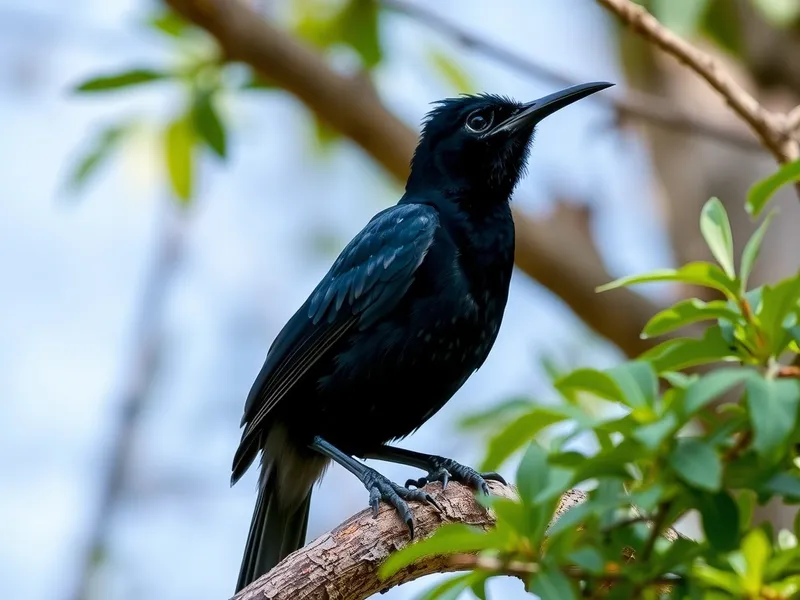
Noisy Friarbird
Philemon corniculatus

Meet the Noisy Friarbird
The Noisy Friarbird is a large, distinctive honeyeater native to eastern and northern Australia, easily identified by its bald, black head and prominent knob atop its bill. Its plumage is mostly brownish-grey, with a pale underbelly and red eyes, giving it a somewhat striking appearance. Known for its loud, raucous calls and gregarious behavior, this bird frequents open forests, woodlands, and urban parks. The Noisy Friarbird is highly active, often seen chasing other birds from flowering trees as it forages for nectar, insects, and fruit.
Classification
Bird
Habitat
Open forests, woodlands, and urban areas
Diet
Omnivore
Lifespan
5-10 years
Conservation
Least Concern
Weight
65-90 grams
📖Fascinating Facts
Vocal Nature
Noisy Friarbirds have a wide range of loud calls, often described as cackling or harsh squawks, which they use to communicate and defend their territory.
Nectar Lovers
They primarily feed on nectar, playing a vital role in pollinating flowering trees such as eucalypts and grevilleas.
Cooperative Nesters
Both male and female Noisy Friarbirds participate in building their cup-shaped nests and caring for the young.
📋Detailed Description
The Noisy Friarbird (Philemon corniculatus) is a conspicuous, large honeyeater measuring 31–36 cm in length, with a wingspan of approximately 45–50 cm and a weight ranging from 70 to 100 grams. Its most distinctive feature is the featherless, black-skinned head topped by a prominent, casque-like knob on the upper mandible, which is thought to play a role in vocal resonance or species recognition. The plumage is predominantly brownish-grey, with paler underparts and a faint scalloping on the breast. The eyes are deep red, and the bill is long, decurved, and robust, well-adapted for probing flowers. The tail is moderately long and slightly rounded. Both sexes are similar in appearance, though females may be marginally smaller. Juveniles resemble adults but have a less pronounced knob and duller eye color. The Noisy Friarbird is highly vocal, producing a variety of loud, metallic, and often harsh calls, including its characteristic 'four o'clock' call, which is used for territory defense and social communication. Its flight is strong and direct, often interspersed with gliding. This species is gregarious, frequently forming loose flocks, especially outside the breeding season, and is known for aggressive interactions with other nectarivores.
💡 Did you know?
Despite their unusual bald heads, Noisy Friarbirds are crucial pollinators for many Australian native plants.
🔬Research & Sources
Wikipedia Summary
The noisy friarbird is a passerine bird of the honeyeater family Meliphagidae native to southern New Guinea and eastern Australia. It is one of several species known as friarbirds whose heads are bare of feathers. It is brown-grey in colour, with a prominent knob on its bare black-skinned head. It feeds on insects and nectar.
Last Modified: 8/6/2024
🎭Behavior & Social Structure
Noisy Friarbirds are diurnal and highly active, spending much of the day foraging in the canopy and mid-story of eucalypt woodlands, open forests, and urban parks. Their diet is omnivorous but primarily nectarivorous, with a strong preference for the flowers of eucalypts, grevilleas, and banksias. They supplement their diet with insects, spiders, and small fruits, especially during the breeding season when protein demands are higher. Foraging is often accompanied by aggressive defense of flowering trees, with individuals or groups chasing away other honeyeaters and even larger birds. Socially, they are loosely colonial, with fluid flock structures outside the breeding season. Vocalizations are central to their behavior, serving functions in mate attraction, territory defense, and group cohesion. Bathing and preening are common, and they are often observed sunning themselves on exposed branches. Roosting occurs communally in sheltered foliage.
👶Reproduction & Life Cycle
Breeding occurs mainly from August to January in southern Australia, but timing can vary with latitude and local conditions. Noisy Friarbirds are monogamous for the breeding season, with pairs establishing and defending territories. The female constructs a large, deep cup-shaped nest from bark, grass, and spider webs, typically suspended from a horizontal tree branch 2–20 meters above ground. Clutch size is usually 2–4 eggs, which are pale pink to buff with reddish-brown blotches. Incubation lasts 14–16 days and is performed solely by the female, while the male assists in territory defense and feeding the young. Both parents feed the nestlings, which fledge after 15–18 days. Post-fledging parental care continues for several weeks. Multiple broods per season are possible in favorable conditions.
🛡️Adaptations & Survival
The Noisy Friarbird exhibits several adaptations for nectarivory, including a long, decurved bill and a brush-tipped tongue for efficient nectar extraction. The bare, black head may reduce pollen accumulation and overheating during foraging. Their raucous vocalizations and aggressive behavior are effective in defending rich food resources from competitors. Flexible social structure allows them to exploit transient food sources, such as mass flowering events. Their ability to thrive in urban and modified landscapes demonstrates behavioral plasticity and tolerance of human disturbance. Seasonal movements, including altitudinal and latitudinal migrations, enable them to track flowering patterns and resource availability.
📚Research Sources
🎨Cultural Significance
The Noisy Friarbird is well-known in Australian folklore for its loud and distinctive calls, which are often described as sounding like 'four o'clock.' Its unusual appearance and boisterous behavior have made it a subject of curiosity and amusement in local communities. In some Aboriginal cultures, friarbirds are associated with seasonal changes, particularly the flowering of certain trees. The species is sometimes featured in children's literature and birdwatching guides, symbolizing the vibrancy of Australian woodlands. There are no significant traditional uses, but its presence is valued for pollination services and as a charismatic component of native avifauna.
🔬Recent Research & Discoveries
Recent research has focused on the Noisy Friarbird's role as a pollinator in eucalypt-dominated ecosystems, with studies highlighting its effectiveness in pollen transfer and its influence on plant reproductive success. Behavioral studies have examined its aggressive interspecific interactions and the ecological consequences of resource monopolization. Genetic analyses have clarified its relationships within the Meliphagidae family, supporting its close affinity with other Philemon species. Ongoing research is investigating the impacts of urbanization on its foraging ecology and breeding success, as well as how climate-driven changes in flowering phenology affect its migratory movements. Citizen science initiatives, such as eBird and the Atlas of Australian Birds, continue to provide valuable data on distribution and population trends.
🎥Wildlife Videos

Birds of Passage - A Secret Journey Through the Skies | Free Documentary Nature
Birds of Passage - A Secret Journey Through the Skies | Wildlife Documentary Watch 'The Sea Eagle - King of the Seas' here: ...
Free Documentary - Nature

The Fascinating World of Sounds in Nature
Wherever you are you can almost always hear animals, but the reasons how and why they make their sounds are as diverse as ...
Free High-Quality Documentaries

Flyways | Full Episode | NATURE | PBS
Watch on your local PBS station, the PBS video app, online, and here on YouTube through February 6, 2028. This program is ...
Nature on PBS

Birds: Melodies, Feathers, and Flight | Full Wildlife Documentary
Melodious calls, vibrant feathers and the power of flight … uplifting, inspiring qualities bestowed on the multitude of birdlife that ...
Get.factual

The Secret Lives of Birds and Their Aerial Feats | Full Documentary
We envy birds their mastery of the air, watching them enjoy the freedom of a 3 dimensional space. Flight allows them to get to hard ...
Free High-Quality Documentaries

David Attenborough Presents: Hummingbirds - Jewelled Messengers | Free Documentary Nature
David Attenborough Presents: Hummingbirds - Jewelled Messengers | Nature Documentary Watch 'Birds of Passage - A Secret ...
Free Documentary - Nature
🌍Habitat Information
The Noisy Friarbird typically inhabits Open forests, woodlands, and urban areas environments. Noisy Friarbirds have adapted to their environments with specialized features and behaviors.
Primary Habitat:
Open forests, woodlands, and urban areas
More detailed habitat information will be available soon.
🛡️Conservation Status
The Noisy Friarbird is currently classified as Least Concern. Conservation efforts are crucial for preserving this species for future generations.
Common Threats:
- 🏠Habitat loss and fragmentation
- 🌡️Climate change impacts
- 🎯Hunting and poaching
- 🏭Human-wildlife conflict
⚠️Threats & Conservation Challenges
Currently assessed as Least Concern by the IUCN, the Noisy Friarbird has a stable and widespread population. However, local declines have been noted in areas of significant habitat loss due to urbanization, land clearing, and the replacement of native vegetation with non-flowering exotics. Competition with introduced species, such as the Common Myna (Acridotheres tristis), and exposure to pesticides in urban areas may pose emerging threats. Climate change could alter flowering phenology and resource distribution, potentially impacting migratory patterns and breeding success. Despite these challenges, the species remains adaptable and resilient in much of its range.
🔬Scientific Classification
Scientific Name
Philemon corniculatus
Classification Hierarchy
🔍 About Taxonomic Classification
Taxonomic classification is a hierarchical system used by scientists to classify and organize living organisms based on shared characteristics and evolutionary relationships.
The system moves from broad categories (Kingdom) to increasingly specific ones, with each animal's scientific name typically consisting of its Genus and species.
📝Community Notes
Share your observations and insights about the Noisy Friarbird with our community of wildlife enthusiasts.
Join Our Community
Sign in to share your observations and connect with fellow wildlife enthusiasts.
Sign In to ContributeNo community notes yet
Be the first to share your observations about the Noisy Friarbird!
Explore Noisy Friarbird
Select a tab above to learn more about this amazing animal.
📸Photo Gallery
No photos available for this animal yet.
🌟Discover More Wildlife
Continue your journey of discovery with more fascinating animals from our database
